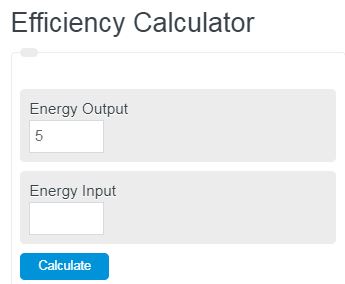Calculate the efficiency of a system. Enter the total energy input into a system, and the total energy or work output to determine its efficiency. This calculator can also determine either the output or input, given the efficiency and the value of the other variable.
Efficiency Formula
Efficiency is the avoidance of waste in any system, often displayed as a percentage of work output to energy input. This energy is usually measured in Joules (J). Efficiency is very often used in applications of heat transfer since heat loss is a core issue in modern-day engineering. It’s also used to evaluate mechanical, solar, and chemical efficiencies.
Efficiency can be calculated through the following formula:
N = Wo / Ei * 100
- Where N is efficiency
- Wo is the work output
- Ei is the energy input
To calculate efficiency, divide the output by the input, then multiply by 100 to express the result as a percentage.
Work and energy both use the standard unit of Joules, but the calculator above is unitless to allow you to input any unit. You need to make sure the units of work and energy match. The above explanation is for the use of efficiency in physics and thermodynamics, but efficiency can be used in anything from finance to work performance.
How to Calculate Efficiency
Efficiency is a measure of a system’s ability to transfer energy. So a system with 100% efficiency will output 100% of the energy input. If you have studied thermodynamics, of course, you know that 10)% efficiency is impossible. There is energy loss in every single aspect of a system, from heat loss to friction loss.
Let’s take a look at an example of how you can calculate efficiency.
- The first step is to calculate or measure the energy being input into a system. This is generally measured through direct means, like measuring the total electricity input into a system, but it can also be calculated.
- The next step is to calculate the total work output. This can sometimes be tricky and require some manipulation of equations. The reason this can be hard is that very often, input is either electricity or heat, and the output is motion, like that of a motor. You must convert physical motion into energy using thermodynamic formulas
- Last, enter the input and output into the formula and analyze the result.
How to improve Efficiency
Improving efficiency is the backbone of continuous improvement in engineering, especially in mechanical systems. Mechanical systems can be extremely inefficient. Take, for example, the ICE (internal combustion engine). The ICE usually averages around 20-30% efficiency. That means, that 70% of the energy provided by gasoline is lost for various reasons. Engineers have been working to improve this for decades.
Here are the best ways to improve the efficiency of mechanical systems:
- Reduce heat loss through the use of insulation
- Reduce the friction of parts through lubrication or redesigning components
- Reduce the number of transfer components. The less, the better
- Capture lost heat to power other systems
There is an unlimited number of ways someone can improve the efficiency of a system, mechanical or not. It’s up to an engineer to think critically and come up with new ways to do that.
